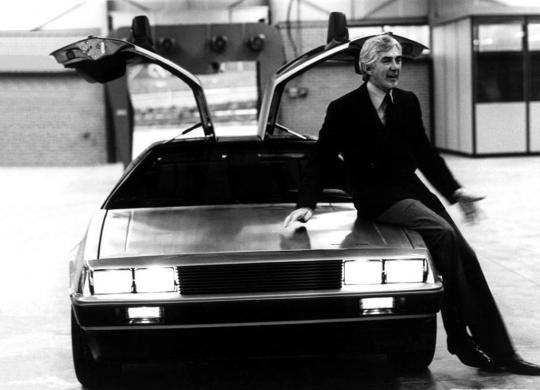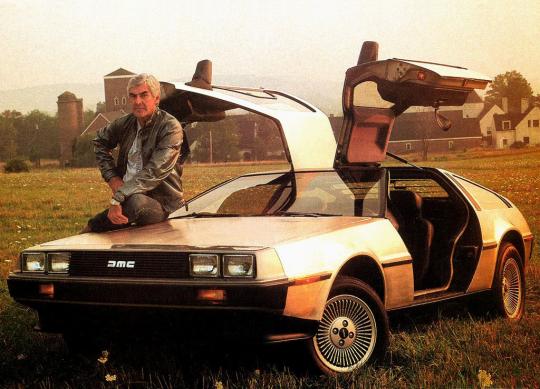He is also the guy whose most famous creation, the DMC-12, encrusted itself into the wet dreams of almost every teenager of the 1980s.
The car's addition as a time-traveling sidekick to the "Marty" character from the "Back to the future" trilogy should have done only good things for its sales success.
Sadly, that didn't happen for a number of reasons which will be revealed later on in this text. Delorean was more than a car guy.The early days

Delorean was the eldest of the four sons of Zachary Sr. and Kathryn Pribak Delorean, a Romanian/Hungarian couple. He was born on January 6, 1925 in the heart of America's car making business – Detroit, Michigan. His father was working as a millwright at Ford Motor Company's foundry, so it's safe to assume that John had cars in his mind since he was young.
Sadly, that was not exactly the case, since his parents divorced over his father's alcoholic and violent tendencies when John was 17 years old. Being the son of immigrants and growing up in Detroit during the Great Depression did amazing things to young Delorean's character. Although he first attended only public grade schools from Detroit, he was eventually accepted into the Cass Technical School, which only accommodate honor students.
Delorean excelled so much at his studies – he had signed for an electrical curriculum – that he earned himself a scholarship at the Lawrence Technological University, where Detroit's best designers and engineers had studied. Being among the top of its class at industrial engineering, he was elected in the school's Honor Society.
From 1943 to 1946, Delorean involuntarily interrupted his studies to serve in the US Army, but he was eventually honorably discharged and he returned to good ol' Detroit only to find his family in economic distress because all his siblings were living off his mother's income.
He resumed his Lawrence Technological University scholarship, but he also took a job for the Public Lighting Commission for more than a year to supplement his family's income. After graduating in 1948, he took a few small-time jobs, like selling insurance and working for the Factory Equipment Corporation, just so he could support himself.Rise to success in the automotive realm

Interestingly, even though Delorean didn't start working in the field he had been trained in right away, he did attend the Chrysler Institute of Engineering – a post-educational facility – at an uncle's recommendation. This way, he was able to advance his education while also gaining a real-life, hands-on approach in engineering in the automotive realm.
After getting his masters degree in automotive engineering from the Chrysler facility he became part of the company's engineering team, while also taking night classes to earn credits for his masters degree in business administration at the University of Michigan's Ross School of Business.
After only a year of working at Chrysler, Delorean jumped boat after he was offered a job at the now-defunct Packard Motor Company. There, his most notable work was his improvement to the Ultramatic automatic gearbox, thus transforming it into the Twin-Ultramatic.
After four years he had already become the head of the research and development department, when he got a call from a man he had great esteem for, Oliver K. Kelley. Kelley was then the vice president of engineering at GM, and he offered Delorean a job at GM's Pontiac division.
It was at Pontiac that he became known as the "father of the muscle car", by being instrumental in the launch of the GTO, aka "The Goat". Almost one quarter of a million Pontiac GTOs were sold in the first five years of production and the brands overall sales almost tripled thanks to Delorean's vision.
Throughout the years at GM, Delorean was being promoted every couple of years or so. In 1969 he had risen as head of the Chevrolet division, while also getting more and more media coverage as the automotive industry's rebel child. He was also beginning to be known in the press as a playboy and a swinger, as he was linked to more than one female celebrity during the years.
After finally being promoted as vice-president for the entire GM car and truck production, getting the absolute top job as the General's CEO appeared to be imminent. Oddly, Delorean unexpectedly quit what seemed to be his dream job in 1973, aged 48. His dreams were apparently greater than that.Epilogue
John Delorean's love affair with the automobile immediately got everyone's attention when he announced that he intended to manufacture a car of his own. The model in question was to be eventually known as the DMC-12, mostly made famous by Steven Spielberg's "Back to the Future" trilogy, in which it played quite a key part.
Sadly, the car that made him an icon in every 1980s teenager's eyes also became eventually responsible for the start of his downfall. After over almost ten years of looking for the sponsors needed to finance the development and manufacturing of the DMC-12, Delorean finally started building the gull-winged coupe in Northern Ireland. After only 21 months of production, what seemed like the company's bright road into the future transformed into a cul-de-sac and the Irish factory went into receivership.
Pressed to find enough money to pay off his debts and restart production of the DMC-12, Delorean got involved into a dubious deal with a former drug smuggler in order to raise cash. What John didn't know at the time was that the drug smuggler was actually an FBI informant, and thus he got caught up in one of the most publicized trials of the 1980s.
Thanks to a procedural defense, Delorean came off clean, but the damage had taken its toll. Engulfed in debt, John became a born-again Christian after the trial, but it all went downhill from there and he never recovered to his former glory. In almost two years of production, a little over eight thousand DMC-12s had been built, of which almost 6000 are believed to still be in existence, thus carrying the legacy of a once great automotive engineer.








